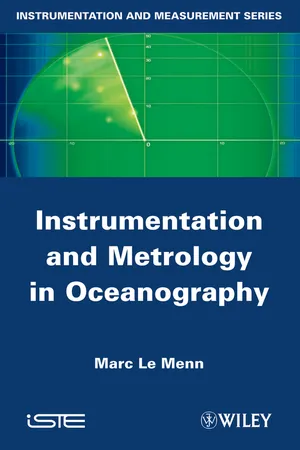![]()
Chapter 1
What We Measure and
What We Process
1.1. The quantities we want to know
Measurements made in physical oceanography have two main aims: to improve our fundamental knowledge of the ocean and the functioning of our planet; and to optimize the use of acoustic tools, which also sometimes help us to gain knowledge of the ocean.
The improvement of fundamental knowledge is integrated with the more general topic of climate change. A global research program was launched in 1979 to try and model this evolution: the World Climate Research Program (WCRP). The WCRP is funded by the World Meteorological Organization (WMO) and UNESCO. To maximize the efforts of different countries with regard to oceanographic measurements, in 1982 the American National Science Foundation launched another program called the World Ocean Circulation Experiment (WOCE). In 1989 it created the WOCE Hydro-graphic Program Office, whose aim was to coordinate, supervise and ensure the quality of measurements taken. To ensure the quality of data collected, it was requested that “the standards to approach in terms of accuracy and reproducibility for the one-time survey, are to be the highest possible under current measuring techniques”. With “repeat surveys, these standards must be approached sufficiently closely to achieve the appropriate regional goals”.
There are several applications of this. The data collected will serve to determine the long-term evolution of ocean circulation. To be able to detect small changes over time, it is necessary to make measurements with low resolution and high reproducibility. The data must be comparable from one country to another and in a common format. Therefore, the measurements should be performed with great accuracy and be comparable to common references. Finally, it should be noted that at great depths the thermal stability of water masses is huge, so to detect small changes over time and space and in order that centers or institutions other than the one that carried out the measurements can verify such changes, the measurements must be made with high resolution, high reproducibility and high accuracy.
In 2003, the WOCE program was relayed by an intergovernmental initiative called the Global Earth Observation System of Systems, which aimed to provide the means to overcome the lack of observations concerning key factors that influence the Earth’s climate. In Europe, another initiative pursuing the same objectives also emerged called the Global Monitoring for Environment and Security (or GMES).
When using acoustic instruments, the specifications are less stringent. Oceanographic measurements performed using these specifications aim to determine the propagation speed or velocity of sound in water either locally or along an acoustic path. It is the temporal and spatial variability of physical characteristics of the environment and the lack of accuracy of velocity references that limit the accuracy of measurements, and that reduced the requirements on the measurement of influence quantities in comparison to those displayed by the WOCE program.
1.1.1. Velocity and density
Whether the measurements are performed to gain environmental knowledge or aim to use acoustic instruments, they have a common point: the measured quantities are the same. Indeed, oceanic circulation largely depends on the density ρ of water masses (the ratio between the mass of a sample and the volume it occupies). Similarly, velocity c is dependent on density. In adiabatic conditions, it is defined by,
where p corresponds to the pressure exerted by the acoustic wave, which results in rapid oscillations in density throughout the medium.
It is well-known that the density of a fluid depends on its temperature, pressure and composition. With variation in density, the velocity will also depend on these parameters. Temperature and pressure are therefore the primary variables to be measured.
The composition of sea water varies locally depending on the quantities of dissolved salts. These amounts change the salinity. Fochhammer introduced this concept for the first time in 1865. Salinity is a chemical parameter of sea water, and a characteristic of water masses, but its definition has continued to evolve since the creation of the concept, as it is a difficult parameter to measure in absolute terms.
The first accurate definition of the salinity of sea water dates from 1902 and was produced by Forch, Knudsen and Sörensen. It follows a protocol of measurement that they had developed showing that:
This is the definition of absolute salinity, Sa, which is expressed in g.kg−1. From this definition, we see that it is not only dissolved salts that are measured but all dissolved matter, so the definition of absolute salinity, carried on to present day, is as follows:
Due to the difficulty of implementation, to date this definition has not been applied in routine measurements. To circumvent these difficulties, a Practical Salinity Scale was defined in 1978 (see section 1.2.3). This scale, which is called PSS-78, calculates a practical salinity S from the simultaneous measurement of temperature, pressure and electrical conductivity in a sample of sea water. The third common variable to be measured is therefore electrical conductivity. It is used to calculate the value of salinity that occurs in density and velocity calculations.
The PSS-78 is based on conductivity measurements — and thus on the speed at which ions move — and does not take into account all dissolved materials, hence biases exist between practical salinity Sp, which we can measure, and absolute salinity. These biases affect the calculation of density. To illustrate this point, let us take the simple example (cited in the TEOS-10 guide), where a small amount of pure water is exchanged with an equivalent mass of silicate compound that is mainly non-ionic. If this exchange takes place at constant temperature and pressure, the value of conductivity will also remain constant, while the absolute salinity and density will have increase...

